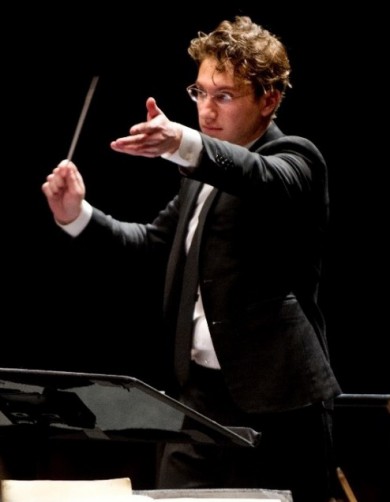Conductor Abrams has a mixed night of multitasking with Fort Worth Symphony

Teddy Abrams performed as conductor and pianist with the Fort Worth Symphony Friday night.
Mozart conducted from the keyboard. It is standard practice in some Baroque ensembles. But performances of 19th and 20th century music almost invariably benefit when the conductor and the piano soloist are two different people.
On Friday evening in Fort Worth’s Bass Hall, Louisville Symphony music director Teddy Abrams both conducted and performed the Ravel Piano Concerto in G Major with the Fort Worth Symphony. The Ravel concerto, with its jazz idioms and smallish orchestra, might seem feasible for a conductor/performer.
There is also a practical advantage to this work for those in dual roles, in that the first and third movements are begun by the orchestra, with the piano coming in a moment later, while the second movement starts with almost three minutes of solo piano. This gave Abrams an opportunity to set tempos.
However, the results were mixed, with Abrams often unable to cue entrances or assist with phrasing or other conductorial tasks. Despite these limitations, the first movement went reasonably well. Abrams is indeed a gifted pianist, and this music is well suited to the strengths of the orchestra— jazz-influenced music and Americana, whether Gershwin or Ravel, has long been in their wheelhouse.
The second and third movements were less successful. In the slow movement, the cadenza-like opening features the melody in the right hand, with a waltz-like accompaniment in the left. Abrams has a beautiful tone, but could have used a clearer sense of line and motion. The orchestra showed what listening within the an ensemble really looks like, but still, a conductor could have helped to solidify entrances and indicate rubato. The extended English Horn solo in the second movement was gorgeous.
The overall effect, though, was of a performance about to slip off the rails at any moment, an effect exacerbated in the third movement, marked Presto. This movement features formidably difficult writing for nearly all instruments. Abrams helped when he could, with a kind of generalized arm-waving during his rare rests. But most of the time, the orchestra was pretty much on its own. Concertmaster Michael Shih did his best to beat time, beginning with smallish head nods and, increasingly larger and more emphatic gestures to keep things on track. Abrams milked the fiery yet playful ending, nearly sliding down the piano bench as he played his last chords.
The audience seemed to love his multi-tasking performance, presenting him with the near-ubiquitous standing ovation as well as a fair amount of cheering. But it was the orchestra thst deserved the cheers, at any rate, for what must have been an anxiety-producing experience.
In the rest of the program, when Abrams confined himself to conducting, he proved himself to be thoughtful and expressive. The only real oddity: Abrams went for long pauses in between movements, to the point of the rests seeming tentative rather than thoughtful or dramatic.
The concert’s opening salvo, Agnegram, by Abrams’ mentor Michael Tilson Thomas, is a lighthearted march “ written in honor of a San Francisco Symphony patron in 1998, was again a good fit for the Fort Worth Symphony. Five percussionists plus a timpanist made for a noisy spectacle with quotations from the 1812 Overture, belying the notion that audiences don’t much enjoy new music. The cacophonous ending was met with equally rowdy cheers.
Sergei Prokofiev’s Symphony No. 5 is probably his best known symphony after the “Classical” No. 1. Written when World War II was raging, it was, according to Prokofiev, to be “a hymn to free and happy Man, to his mighty powers, to his pure and noble spirit.”
Abrams and the FWSO exemplified this noble theme through huge dynamic contrasts in the first movement, culminating in the thrilling, loud coda.
The second movement’s tricky string writing was ably dispatched by the Fort Worth musicians. First violins, especially, exhibited near-flawless ensemble and intonation. Abrams and the orchestra effectively managed the third movement’s somber tone. Tubist Edward Jones was an especial standout with his rich tone.
The fourth movement included the only moments of uncertainty in the performance, with a lack of cohesive ensemble, although individual solo playing was often excellent. The Fort Worth Symphony sounds better than ever these days; violins in particular are spectacular, clean, crisp, and agile.
The program will be repeated 7:30 p.m. Saturday and 2 p.m. Sunday at Bass Hall. fwsymphony.org; 817-665-6000


